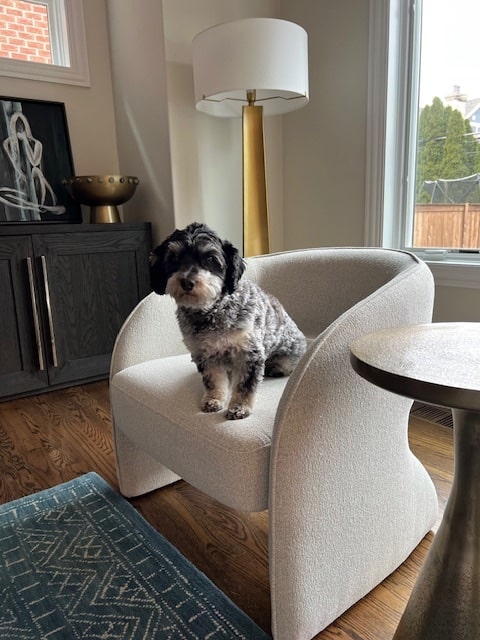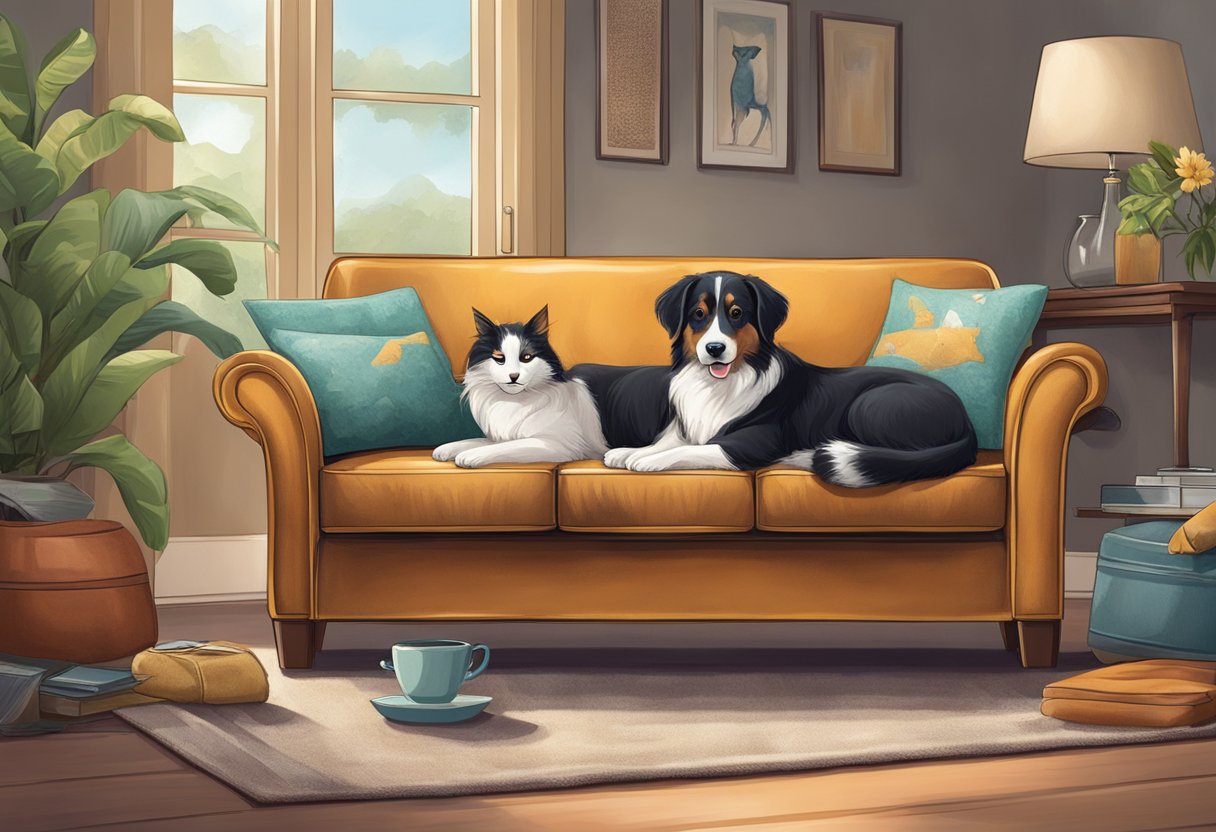Selecting the best couch fabric for homes with dogs and cats is an important decision for pet owners. The right fabric not only provides comfort and style but also withstands the wear and tear from pets. It must resist scratches and be easy to clean, ensuring the longevity of the furniture. Whether cuddling with a furry friend or dealing with the occasional mess, the material of a couch can make all the difference in a pet-friendly home.

When considering upholstery options, pet owners should look for durable fabrics like microfiber, canvas, or leather. Microfiber is particularly popular due to its tight weave, which makes it resistant to punctures from claws. Additionally, its ease of cleaning helps in removing pet hair and stains. Canvas fabrics offer a similar level of durability and are often used in slipcovers. Leather, on the other hand, provides a luxurious feel and can be easily wiped down, though it can show scratches more easily over time.
It’s not just about durability; comfort for both pets and owners plays a significant role in choosing the right couch fabric. Pet-friendly couch materials come in various textures and colors, offering a blend of practicality and aesthetics. Selecting the appropriate upholstery helps in maintaining a clean, welcoming living space that caters to the needs of every family member, including the four-legged ones.
Choosing the Right Fabric
When selecting a couch fabric suitable for homes with dogs and cats, it’s essential to prioritize materials that are durable, easy to clean, and provide comfort.
Pet-Friendly Fabrics Overview
- Microfiber: A synthetic fabric known for its durability and resistance to scratches.
- Leather: Highly recommended for pet owners due to its longevity and ease of cleaning despite potential for scratches.
- Canvas: Often used in slipcovers; sturdy and washable, a practical choice for pet households.
Durability Considerations
- Tight Weave: Tightly woven fabrics are less likely to snag on pets’ claws.
- Color: Darker colors or patterns can hide pet hair and stains better than lighter shades.
- Material Strength: Denser textiles, such as leather and microfiber, withstand the active lifestyle of pets.
Ease of Cleaning
- Removable Covers: Some sofas offer removable covers that can be machine washed.
- Stain Resistance: Fabrics treated for stain resistance allow for easier spot cleaning.
- Non-absorbent Materials: Surfaces that do not absorb spills prevent odors and stains from setting in.
Texture and Comfort
- Soft to Touch: Fabrics like microfiber provide a plush surface for both pets and owners.
- Temperature Regulation: Materials such as leather adapt to body heat quickly, offering a comfortable resting surface.
- Smooth Surfaces: Easier for pet hair removal and generally provide a more consistent appearance over time.
Types of Fabrics
When selecting a couch fabric that is suitable for homes with dogs and cats, one must consider durability, ease of cleaning, and resistance to scratches and stains.
Microfiber Options
Microfiber is a dense, synthetic fabric that’s highly resistant to scratches and odors, making it ideal for pet owners. Its fine threads are woven tightly, which helps prevent pet hair from sticking and makes it easier to clean.
- Pros:
- Scratch-resistant
- Easy to clean
- Cons:
- Can retain heat
Leather Varieties
Leather is a strong material that withstands scratches and can be relatively easy to maintain. It often develops a patina over time that can hide small imperfections caused by pets.
- Pros:
- Durable
- Can improve with age
- Cons:
- Susceptible to puncture from sharp claws
Canvas and Denim
Both canvas and denim are tightly woven, heavy-duty fabrics. They are known for their toughness and can handle the wear and tear that pets often inflict.
- Pros:
- Sturdy and long-lasting
- Machine washable (if slipcovers are used)
- Cons:
- Less luxurious feel
Synthetic Blends
Synthetic blends, like polyester or nylon mixed with other fibers, provide durability while still remaining aesthetically pleasing. These fabrics are typically treated for increased stain resistance.
- Pros:
- Versatile in design
- Stain-resistant
- Cons:
- May not be as breathable as natural fabrics
Fabric Treatments
When selecting couch fabric for pets, it is essential to consider treatments that enhance the fabric’s durability and maintenance. These treatments should cater to both stain and odor resistance, ensuring the fabric’s longevity and freshness.
Stain Resistance
Fabrics with stain resistance are treated with a protective coating that repels liquids and prevents stains from setting in. This is crucial for pet owners as it eases cleaning efforts and maintains the couch’s appearance. Examples include:
- Microfiber: A synthetic fabric often treated for stain resistance.
- Crypton: A patented fabric highly resistant to stains, moisture, and odors.
Common Stain-Resistant Treatments:
| Treatment Type | Description |
|---|---|
| Nanotechnology | Creates a barrier at the molecular level to resist stains. |
| Scotchgard™ | A spray-on treatment that repels liquids. |
| GreenShield® | An eco-friendly option for fabric protection. |
Application: Manufacturers apply these treatments to fabrics either during the production process or post-manufacture as a finish.
Odor Resistance
Couch fabrics with odor resistance inhibit the growth of bacteria and mold, which are often the sources of unwanted smells. This feature not only keeps the couch smelling fresh but also contributes to a healthier living environment.
Key Materials with Built-in Odor Resistance:
- Leather: Naturally resists odors and is easy to clean.
- Synthetic Fibers: Can include antimicrobial properties to combat odor-causing bacteria.
Popular Odor-Resistant Treatments:
- Ultra-Fresh™: Antimicrobials added to fabrics to control odors.
- Microban®: A treatment providing continuous odor and bacteria protection.
Treatments can vary in their longevity and may need reapplication over time.
Fabric treatments are an integral part of keeping a pet-friendly home. They ensure couch fabrics remain in top condition despite the challenges posed by dogs and cats.
Design Tips
When choosing the best couch fabric for homes with dogs and cats, one must consider color and patterns that will gracefully disguise pet hair and withstand wear.
Color Selection
Selecting the right color is crucial for maintaining a clean look. Homeowners should prefer darker hues or shades that match their pet’s fur color, as these will excel at hiding hair and stains.
- Recommended Colors:
- Dark grey
- Navy blue
- Earth tones such as taupe or mocha
Pattern Ideas
Patterns can be beneficial in masking pet-related wear and tear. Owners may opt for intricate designs which draw the eye away from imperfections.
- Effective Patterns:
- Tweed
- Herringbone
- Small geometric patterns
Maintenance and Care
Maintaining and caring for couch fabrics with pets in mind involves regular cleaning and prompt repair of minor damage to ensure longevity.
Regular Cleaning Tips
To maintain the fabric of a couch used by dogs and cats, cleaning routines need to be thorough and frequent. Create a weekly cleaning plan to remove pet hair, dirt, and dander.
- Vacuuming: Use a vacuum with a brush attachment to gently but effectively remove pet hair and dirt from the surface.
- Spot Cleaning: Address spills and stains immediately using a pet-safe upholstery cleaner.
- Washing Covers: If the couch has removable covers, wash them according to the manufacturer’s instructions, typically in cold water on a delicate cycle.
Repairing Minor Damage
Pets can cause minor damage such as scratches, snags, or small tears. Here’s how to handle these issues:
Snags and Loose Threads:
- Gently push the snag through to the back of the fabric using a needle.
- Secure the thread on the backside with a small knot.
Small Tears or Holes:
- Use a needle and thread that matches the couch fabric color to sew the tear closed.
- If sewing isn’t an option, fabric adhesives can be a temporary solution for bonding the edges of the tear.
Additional Considerations
When selecting the best couch fabric for pets, it’s crucial to consider potential allergies and the environmental impact of the fabric. These factors can significantly affect both the health of the household and the sustainability of the purchase.
Allergies and Sensitivities
Pets can have allergies, just like humans, and certain fabrics may trigger allergic reactions. Additionally, humans with sensitivities can be affected by the pet dander that accumulates on furniture.
- Hypoallergenic Fabrics: Some fabrics are more resistant to allergens, making them a preferred choice for households with allergy concerns. Materials such as microfiber and certain tightly woven fabrics are less likely to harbor allergens.
- Ease of Cleaning: Fabrics that can be easily cleaned will reduce the presence of allergens. Look for removable cushion covers that are machine washable.
Environmental Impact
The production and disposal of couch fabrics can have a significant impact on the environment. Sustainable choices benefit not only the household but also the planet.
- Sustainable Materials: Natural fibers like cotton or linen are often more sustainable, but make sure they are treated to be durable against pets.
- Recycled Options: Fabrics made from recycled materials can also be a pet-friendly and eco-conscious choice, providing a use for materials that might otherwise end up in landfills.
Conclusion
When selecting the ideal couch fabric for homes with dogs and cats, several factors contribute to a wise decision. Durability and ease of cleaning are principal considerations. The best options tend to include:
- Microfiber: Noted for its resilience and simple spot-cleaning requirements.
- Leather: Valued for its ability to repel fur and its straightforward maintenance.
- Canvas or denim: Recognized for their robustness in withstanding pet wear and tear.
Pet owners should consider:
- Color: Darker hues mask pet hair and stains more effectively.
- Pattern: Patterns can help conceal imperfections between cleanings.
- Texture: A tightly woven texture deters claws from snagging the fabric.
It’s important to avoid materials like velvet or chenille, which attract hair and are more prone to damage. Treatments like stain repellents or antimicrobial finishes can enhance fabric defense, extending the life and appearance of the couch. Always consider pets’ habits, like scratching or shedding, to align with the most appropriate fabric choice. Investing in durable, pet-friendly couch fabric ensures a harmonious living space for both the pet owners and their furry companions.







